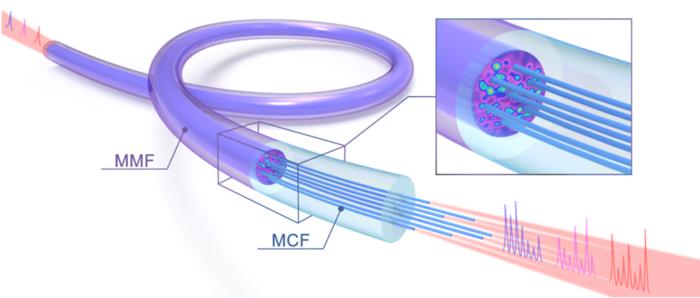Accurate high-speed measurements of wavelength are fundamental to optical research and industrial applications, such as environmental monitoring, biomedical analysis, and material characterization. Recent studies have shown that a disordered scattering medium such as a multimode fiber can generate a wavelength-dependent speckle pattern, which can provide a high spectral resolution and broad operational bandwidth in a compact structure. However, the measurement speeds of current speckle spectrometers are constrained by cameras, which limits their applications.

Credit: by Zheng Gao, Ting Jiang, Mingming Zhang, Yuxuan Xiong, Hao Wu, and Ming Tang.
Accurate high-speed measurements of wavelength are fundamental to optical research and industrial applications, such as environmental monitoring, biomedical analysis, and material characterization. Recent studies have shown that a disordered scattering medium such as a multimode fiber can generate a wavelength-dependent speckle pattern, which can provide a high spectral resolution and broad operational bandwidth in a compact structure. However, the measurement speeds of current speckle spectrometers are constrained by cameras, which limits their applications.
In a new paper published in Light: Advanced Manufacturing, a team of scientists, led by Professor Ming Tang and Dr. Hao Wu from Huazhong University of Science and Technology, China, with doctoral students Zheng Gao and Ting Jiang as co-first authors, have developed an ultrafast wavemeter based on multimode and multicore fibers, which employs spectral–spatial–temporal mapping. By integrating the speckle pattern characteristics of multimode fibers with the sampling capabilities of multicore fibers, this new method achieves a spectral measurement speed of 100MHz without compromising accuracy. These scientists summarize the operational principle of their wavemeter:
“To break through this speed limitation, we introduced multicore fibers, proposing an innovative spectral-space-time mapping scheme. We fused multicore fibers to the output end of multimode fibers, using each core to sample the speckle pattern, effectively transforming the intensity distribution into a pulse signal sequence. As a result, high-speed single-pixel photodetectors replaced traditional cameras, overcoming the frame rate limitations and achieving a leap in measurement speed.”
“We experimentally demonstrated a measurement rate of 100 MHz while maintaining a high resolution of 2.7pm. This measurement method has significant potential for application in many fields.”the scientists forecast.
Journal
Light: Advanced Manufacturing



